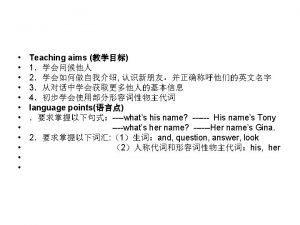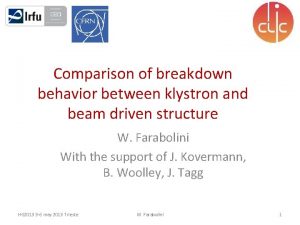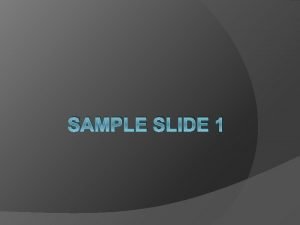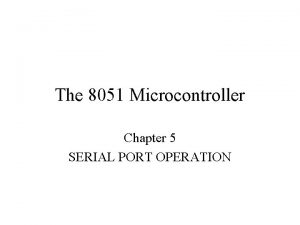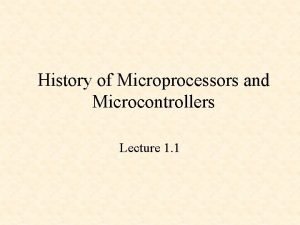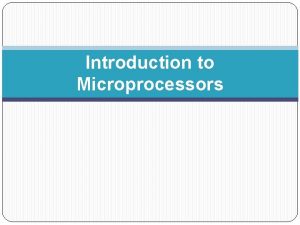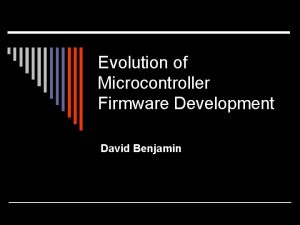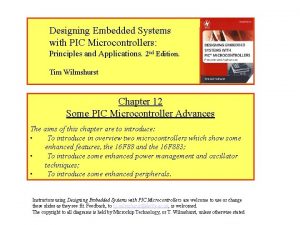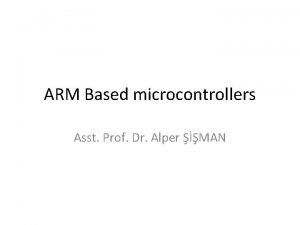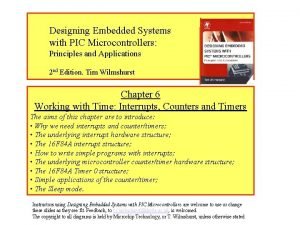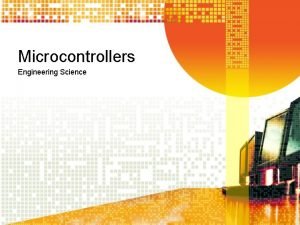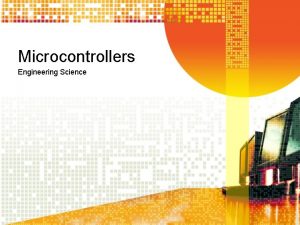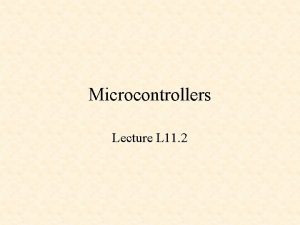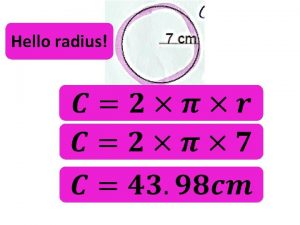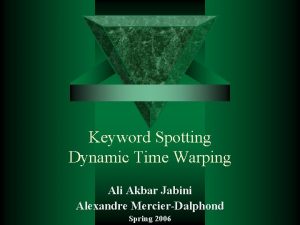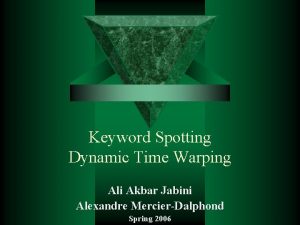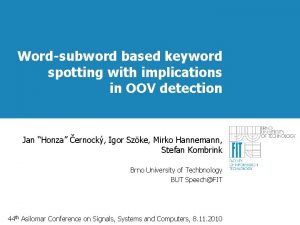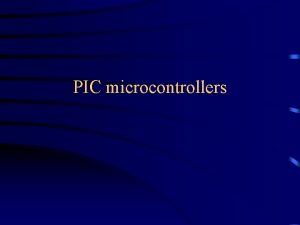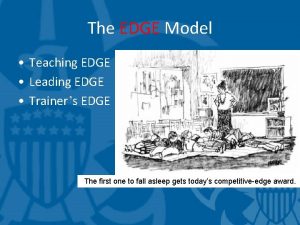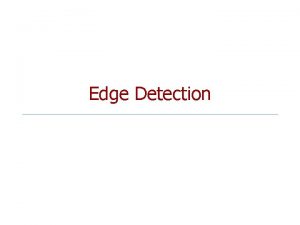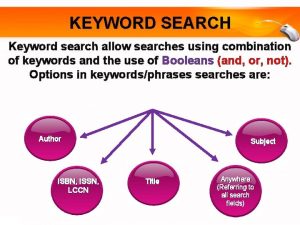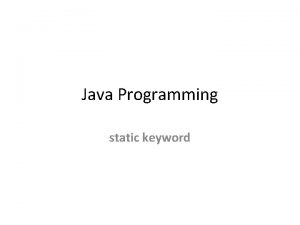Hello Edge Keyword Spotting on Microcontrollers Yundong Zhang
























- Slides: 24

Hello Edge: Keyword Spotting on Microcontrollers Yundong Zhang①②, Naveen Suda①, Liangzhen Lai①, Vikas Chandra① ①Arm, San Jose, CA ②Stanford University, Stanford, CA ar. Xiv: 1711. 07128 v 3 [cs. SD] 14 Feb 2018

Why to select this one from papers? 1. Edge computing gateway(soc, eg. honeywell JACE, raspberrypi), device(mcu, eg. stm 32) 2. ARM machine learning project CMSIS-NN code for microcontrollers. 3. Pattern Recoginition, keyword spotting critical component for enabling speech based user interactions on smart devices, for example, door lock. 4. small data feature, litte sample a research direction of AI.

Abstract 1. Keyword spotting(KWS), a critical component , real-time response and high accuracy 2. neural networks an attractive choice for KWS because of superior accuracy compared to traditional algorithms. 3. Resource constrained power budget, limited memory and compute capability. 4. neutral networks evaluation/optimisation KWS within the memory and compute constraints of microcontrollers without sacrificing accuracy. 5. depthwise separable convolutional neural network(DS-CNN) higher accuracy than the DNN model with similar number of parameters. 2016 -2017 published

I. Introduction II. Background CONTENTS III. Neural Network Architectures for KWS IV. Experimental and Results V. Conclusions

I. Introduction service(include AI) migration from cloud to edge or terminal 1. latency of communication with cloud 2. privacy concern

I. Introduction low power consumption requirement for keyword spotting systems, select mcu, hardware/embedded system low cost, low energy, low size, digital signal processor, microcontroller, cortex-m, stm 32, system of chip, cortex-a, raspi, software/nn https: //github. com/ARM-software/ML-KWS-for-MCU challenges and contributions train KWS nn model new KWS using depth-wise separable convolutions and point-wise inspired by Mobile. Net resource-constrained nn

II. Background Keyword Spotting (KWS) System a feature extractor and a neural network based classifier Input speech signal parameters L: signal length l : overlapping frame length s: stride length T: frame number F: speech feature number per frame LFBE and MFCC common for human-engineered speech feature extraction , time-domain speech signal into a set of frequency-domain spectral coefficient dimensionality compression Classifier Neural Network traditional speech recognition for KWS:HMMs and Viterbi decoding

II. Background Microcontroller Systems processor core SRAM flash Characteristics Low-cost and high-energy efficient Low compute ability So, some improvement Intergrated DSP instuctions SIMD MAC Arm Mbed platform processor frequency SRAM Flash STM 32 F 103 CBT 6 Cortex-M 3 48 MHz 20 K 128 K STM 32 L 431 RCT 6 Cortex-M 4 80 MHz 64 K 256 K STM 32 L 471 RET 6 Cortex-M 4 80 MHz 128 K 512 K Nucleo F 746 ZG Cortex-M 7 216 MHz 320 K 1 M

III. Neural Network Architectures for KWS Different neural network DNN CNN RNN CRNN DS-CNN

III. Neural Network Architectures for KWS RNN superior performance in many sequence modeling tasks, especially speech recognition, language modeling, translation temporal relation long-term dependencies using gate machinisam RNN Cell could be LSTM cell, gated recurrent unit GRU less parameters than CNN normalized

III. Neural Network Architectures for KWS CRNN A hybrid of CNN and RNN exploit the local temporal/spatial correlation starts with a convolution layer followed by an RNN GRU used as RNN based a dense full-connected layer

III. Neural Network Architectures for KWS DS-CNN first convolve each channel in the input feature map with a separate 2 -D filter decomposing the 3 D into 2 D convolution average pooling followed by a full-connected layer see also paper, <Xception Deep Learning with depthwise separable convolutions >

IV. Experiments and Results Google speech command dataset 64 K 1 -second long audio clips of 30 words thousands of different people each clip consisting only one keyword NN model classify the incoming audio into one of 10 keywords Data split into training 80% validation 10% test 10% Google Tensorflow framework cross-entroy loss and Adam optimizer a batch size 100 20 k iterations learning rate of 5*10 -4, traning data is augmented with backgroud noise and random time shift of up to 100 ms

IV. Experiments and Results experiments 1 40 MFCC features extracted from a speech frame of length 40 ms with a stride of 20 ms 1960(49*40)features for 1 second of audio DNN not the best accurary and memory intensive less number of operations/inference suit well to limited compute capacity CNN higher accurary than DNN cost larger number of operations and memory requirement LSTM and CRNN balance memory and operations and accurary

IV. Experiments and Results Classifying Neural Networks for KWS based on Resource Requirements two important considerations for memory footprint execution time Derive three sets of constraints for the neural networks small medium large

IV. Experiments and Results Resource Constrained Neural Network Architecture Exploration target: high accuracy, small memory footprint and lower number of computation The following figure show the actual accuracy, memory and ops of various model

IV. Experiments and Results Resource Constrained Neural Network Architecture Exploration-2 comparation of DNN, CNN LSTM, GRU, CRNN, DS-CNN hyperparameters

IV. Experiments and Results

IV. Experiments and Results Neural Network Quantization trained with floating point weights and activations quantized into integers during inference without any loss of performance Qm. n format, a fixed point number format Q 1. 14 , 1 integer bit and 14 fractional bits Q format used in hardware that does not have a floating-point unit Quantization flow value convertion weight are quantize to 8 -bit one layer

IV. Experiments and Results KWS for microcontrollers deploy the KWs application on Cortex-M 7 based STM 32 F 746 G-DISCO development board using CMSIS-NN kernels each inference, including memory copying, MFCC feature extraction and DNN exectution , takes about 12 ms microcontroller can be put into wait-for-interrupt mode for the remaining time for power saving. KWS application occupies ~70 KB memory, including ~66 KB for weight, ~1 KB for activation and ~2 KB for audio I/O and MFCC features

IV. Experiments and Results KWS for microcontrollers some change of op external circuit for better performance on F 407

IV. code and other useful material Code folder {"Silence", "Unknown", "yes", "no", "up", "down", "left", "right", "on", "off", "stop", "go"};

V. Conclusion Hardware optimized neural network architecture key to get efficient results on memory and compute contrained microcontrollers. trained various neural network architectures for keyword spotting CNN, DNN, RNN, CRNN, LSTM etc quantized representative 32 bit floating-point into 8 bit fixed point versions models can easily be quantized for deployment without any loss in accuracy even without retraining a new KWS model using depthwise separable convolution layer, inspired from Mobile. Net we derived three sets of memory/compute constraints Based on typical microcontroller systems, or the neural networks and performed resource constrained

2018 THANK YOU
 Hello edge: keyword spotting on microcontrollers
Hello edge: keyword spotting on microcontrollers Hi morning
Hi morning Hello hello hello how are you
Hello hello hello how are you Hello hello hello what's your name
Hello hello hello what's your name Rising edge and falling edge
Rising edge and falling edge Hello good afternoon google
Hello good afternoon google I'm muzzy big muzzy
I'm muzzy big muzzy Hello everyone
Hello everyone Come on everybody stand up stand stamp your feet
Come on everybody stand up stand stamp your feet Hello peter pan
Hello peter pan Hello pt
Hello pt Birchfield nursery
Birchfield nursery Hello hello to everyone it's english time
Hello hello to everyone it's english time Hello my friend song
Hello my friend song Hello hello 1 2 3
Hello hello 1 2 3 Hello my future
Hello my future How many serial ports are there in 8051 microcontroller
How many serial ports are there in 8051 microcontroller History of microcontrollers
History of microcontrollers Embedded innovator winter 2010
Embedded innovator winter 2010 Microcomputer features
Microcomputer features Evolution of microcontrollers
Evolution of microcontrollers Designing embedded systems with pic microcontrollers
Designing embedded systems with pic microcontrollers Introduction to microcontrollers
Introduction to microcontrollers Arm based microcontrollers
Arm based microcontrollers Designing embedded systems with pic microcontrollers
Designing embedded systems with pic microcontrollers



